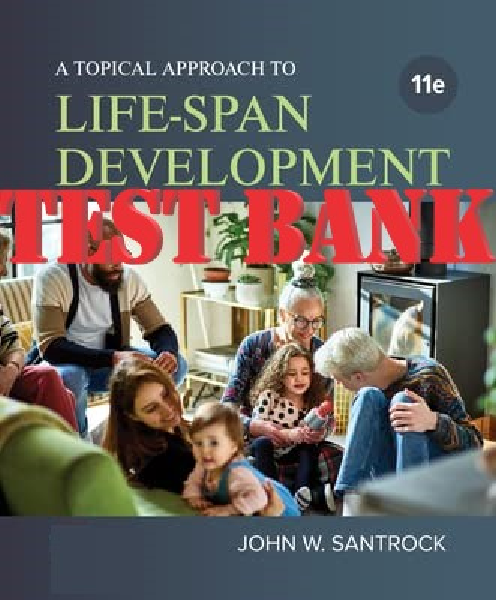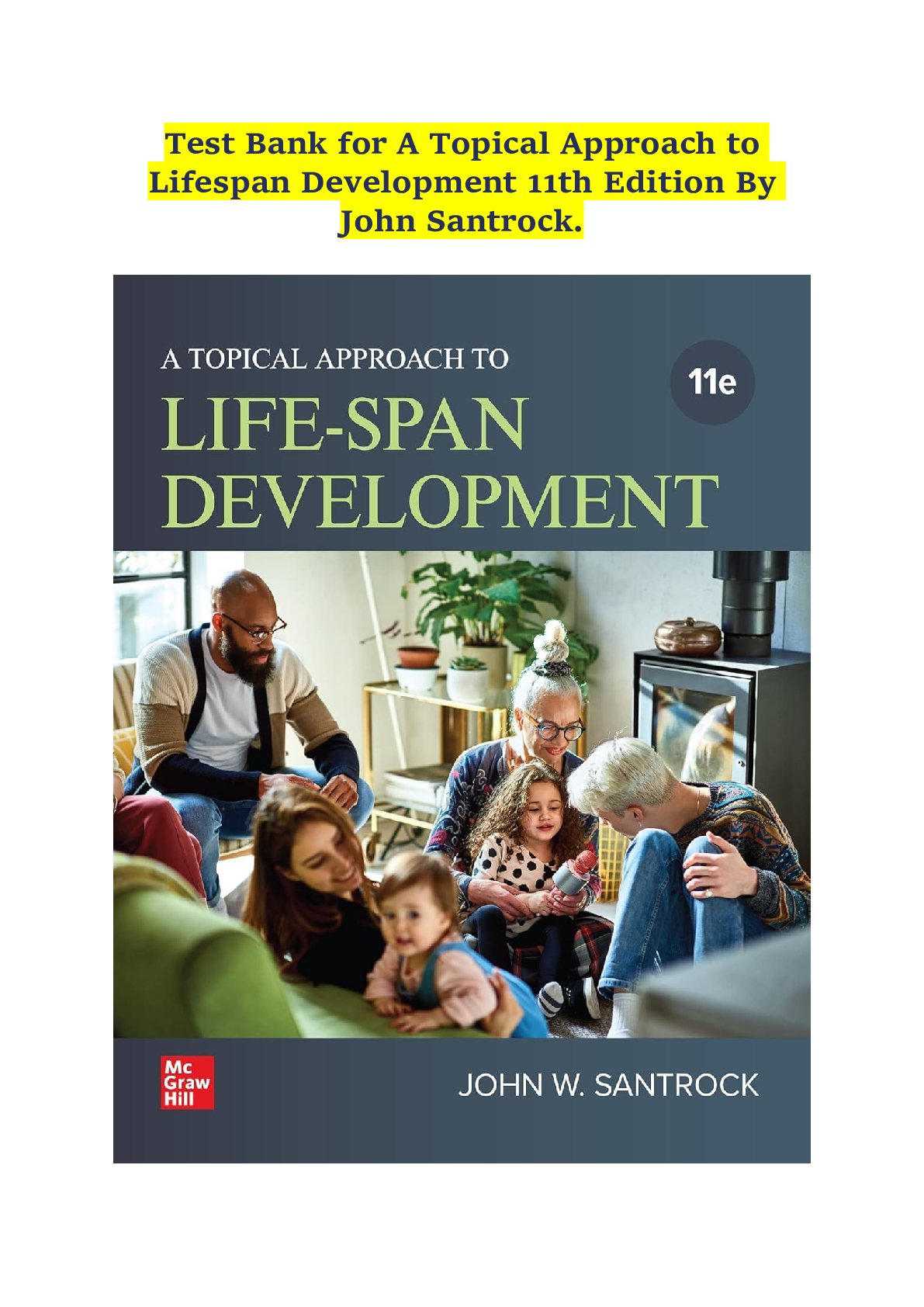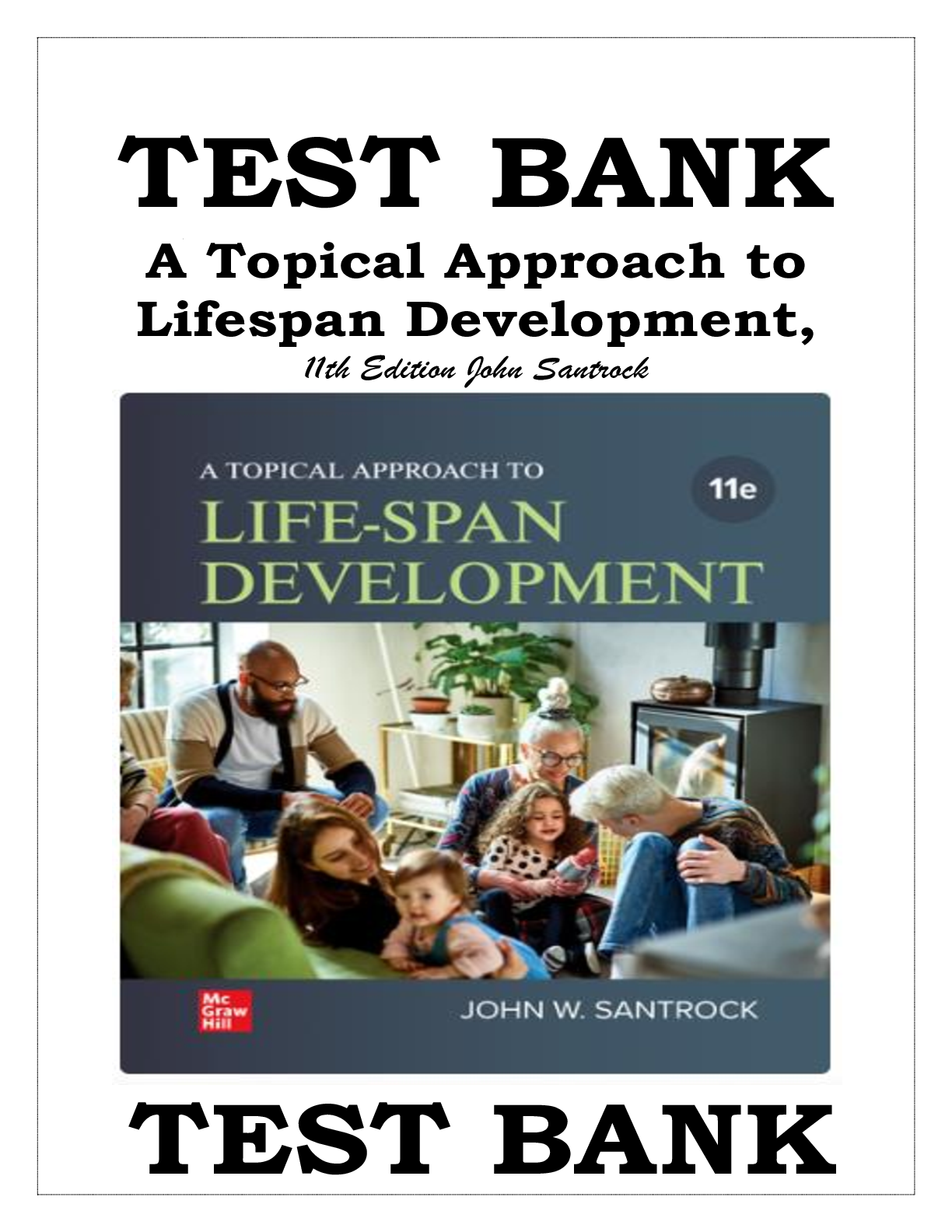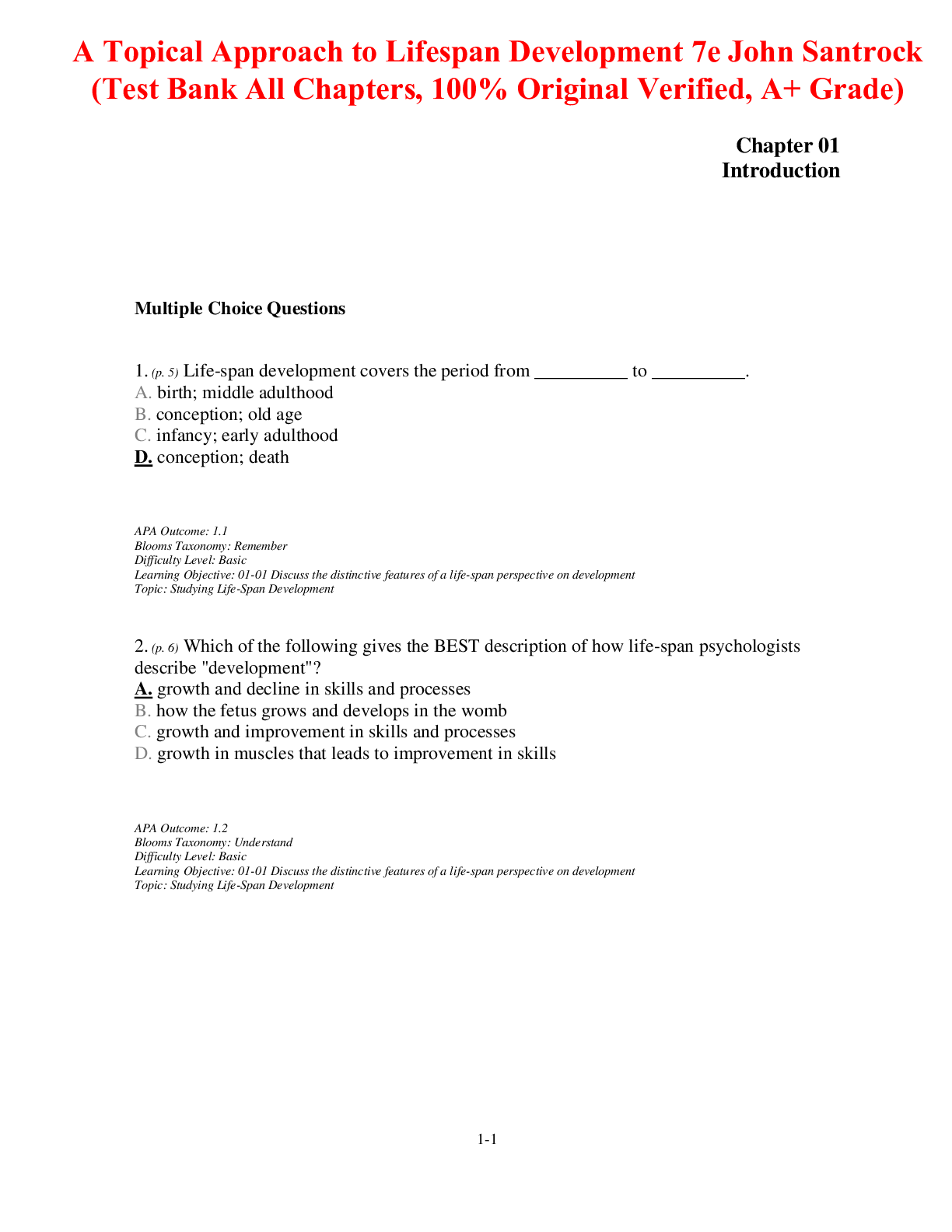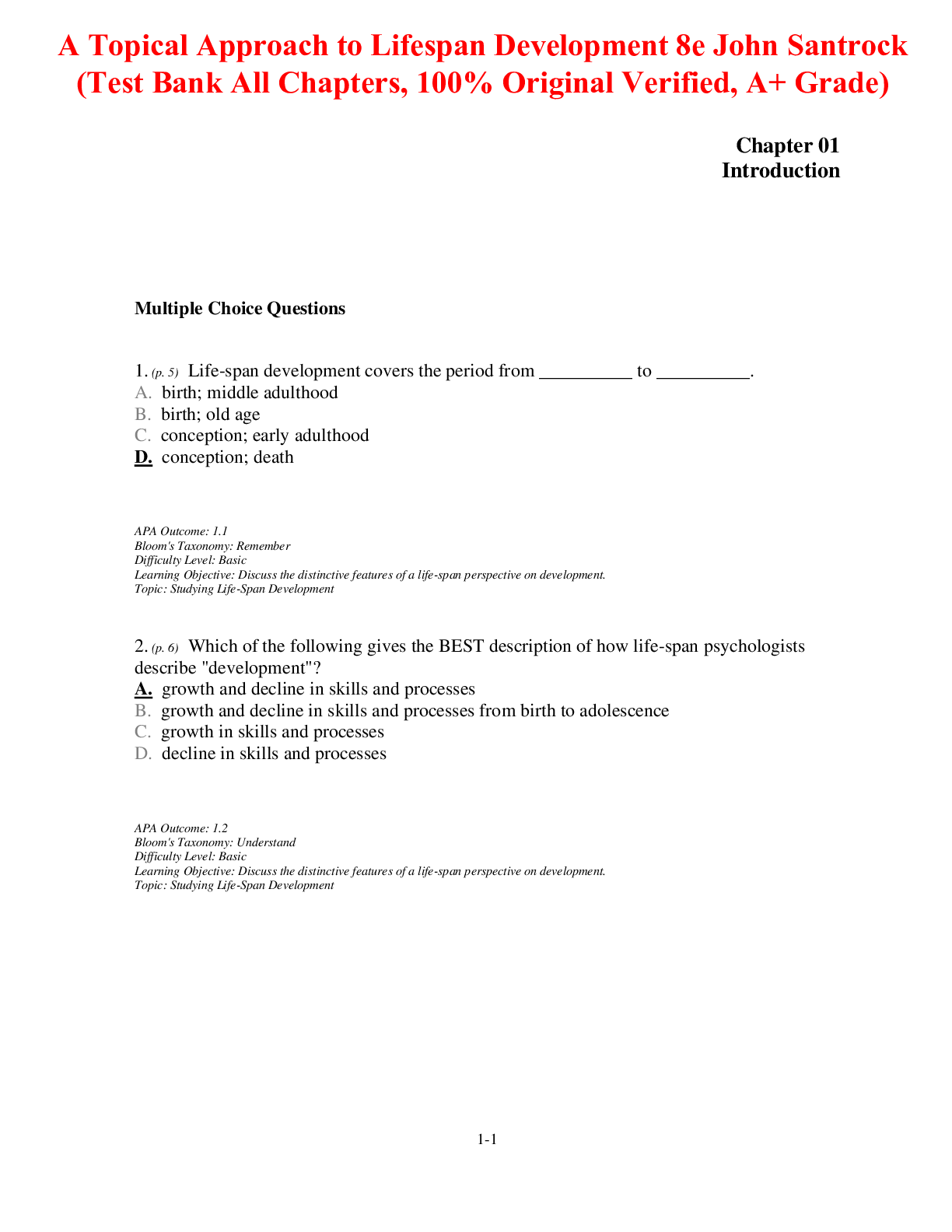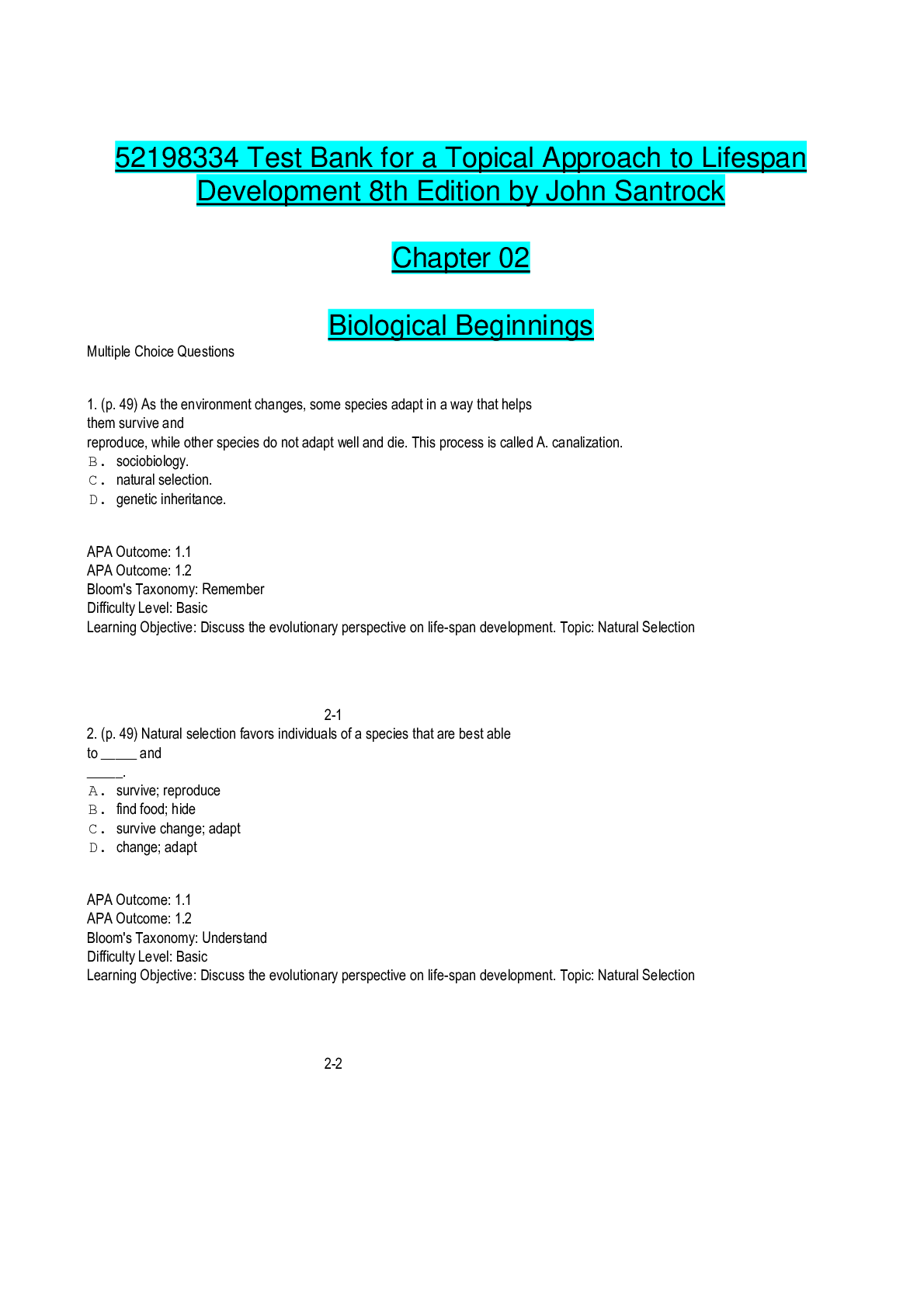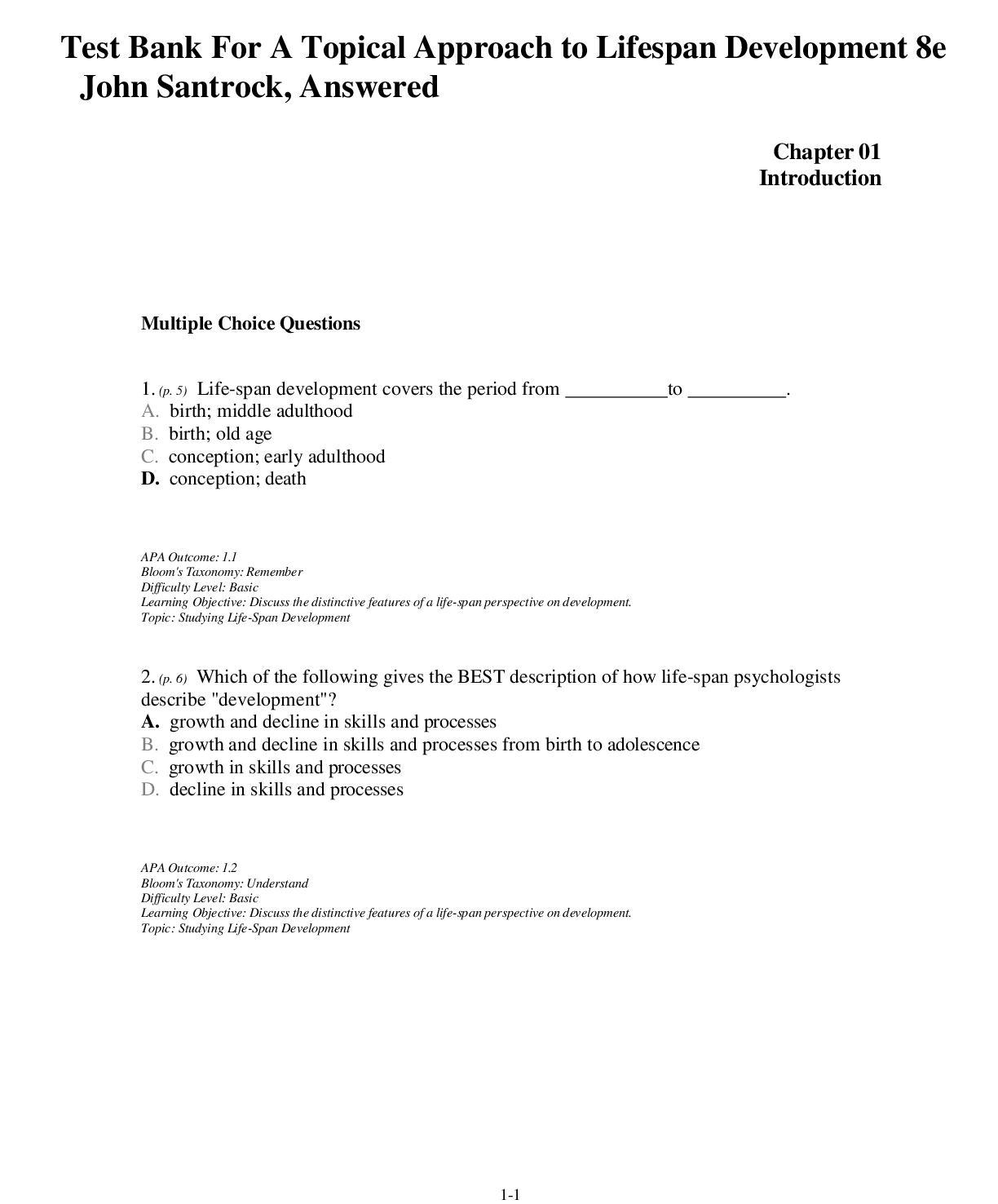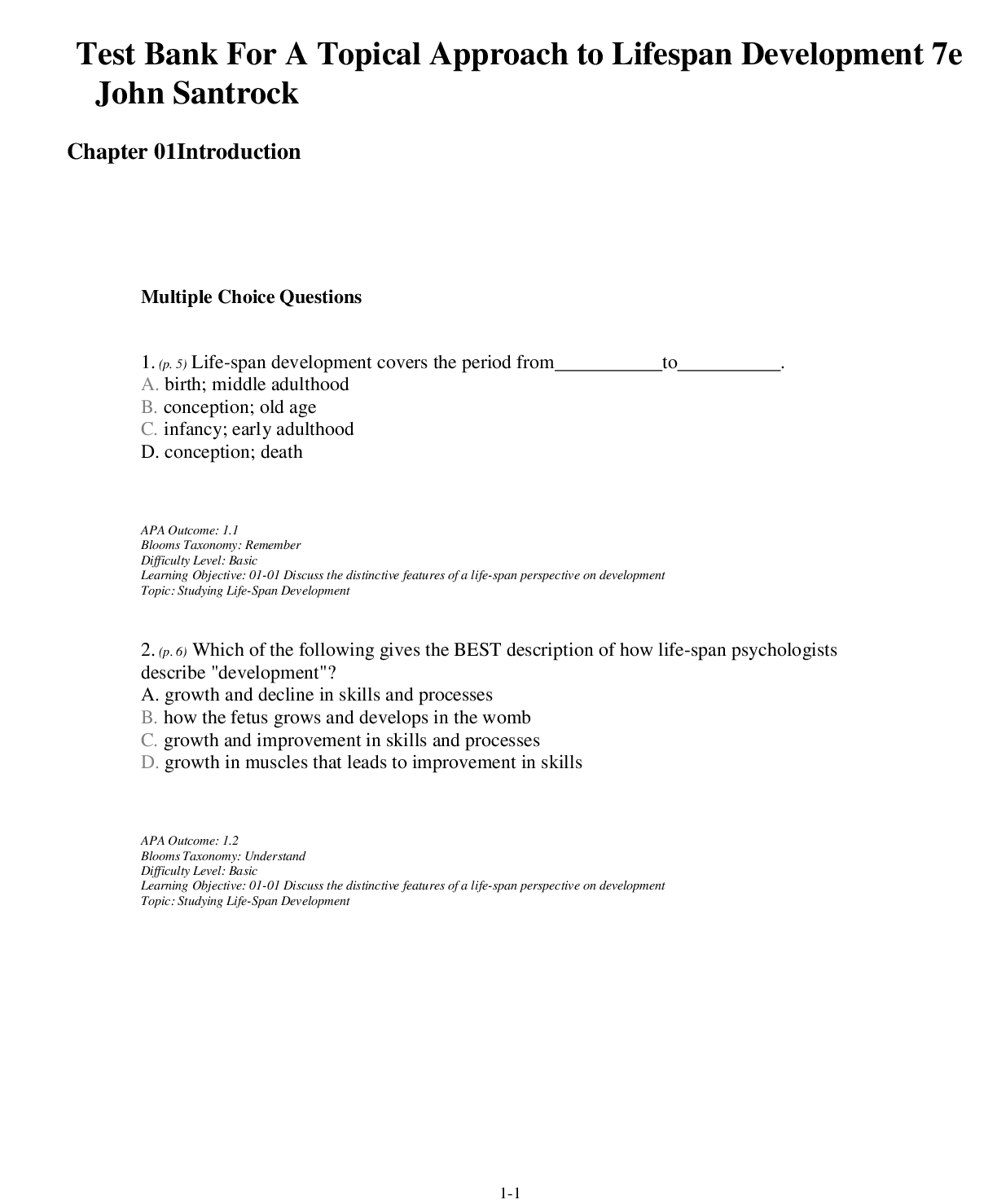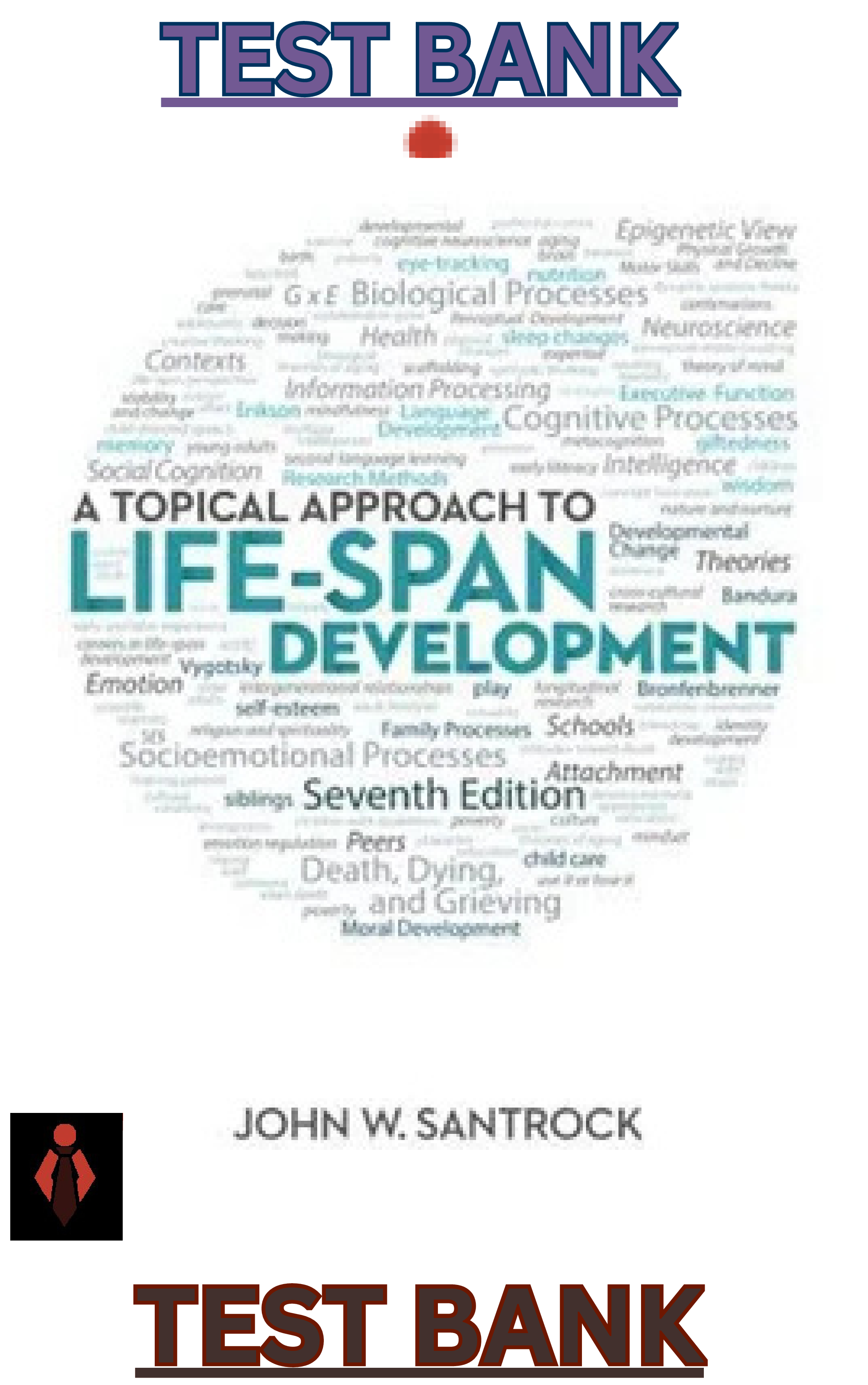Education > TEST BANKS > Test Bank for A Topical Approach to Lifespan Development 8e John Santrock (All)
Test Bank for A Topical Approach to Lifespan Development 8e John Santrock
Document Content and Description Below
Test Bank for A Topical Approach to Lifespan Development 8e John Santrock-1. (p. 5) Life-span development covers the period from to . A. birth; middle adulthood B. birth; old age C. conception; ear... ly adulthood D. conception; death APA Outcome: 1.1 Bloom's Taxonomy: Remember Difficulty Level: Basic Learning Objective: Discuss the distinctive features of a life-span perspective on development. Topic: Studying Life-Span Development 2. (p. 6) Which of the following gives the BEST description of how life-span psychologists describe "development"? A. growth and decline in skills and processes B. growth and decline in skills and processes from birth to adolescence C. growth in skills and processes D. decline in skills and processes APA Outcome: 1.2 Bloom's Taxonomy: Understand Difficulty Level: Basic Learning Objective: Discuss the distinctive features of a life-span perspective on development. Topic: Studying Life-Span Development Chapter 01 - Introduction 1-2 3. (p. 6) Life-span development is the study of human development from conception to death. Historically, however, most of the focus has been on which age group? A. children and adolescents B. young adults C. middle-aged adults D. the elderly APA Outcome: 1.2 Bloom's Taxonomy: Remember Difficulty Level: Basic Learning Objective: Discuss the distinctive features of a life-span perspective on development. Topic: Studying Life-Span Development 4. (p. 6) The upper boundary of the human lifespan is years. A. 105 B. 117 C. 122 D. 131 APA Outcome: 1.2 Bloom's Taxonomy: Remember Difficulty Level: Basic Learning Objective: Discuss the distinctive features of a life-span perspective on development. Topic: Characteristics of Life-Span Perspective 5. (p. 6) Although the maximum life span of humans has not changed, during the twentieth century, life expectancy A. in the U.S. has increased by 15 years. B. in the world has increased by 15 years. C. in the U.S. has increased by 30 years. D. in the world has increased by 30 years. APA Outcome: 1.2 Bloom's Taxonomy: Remember Difficulty Level: Basic Learning Objective: Discuss the distinctive features of a life-span perspective on development. Topic: Characteristics of Life-Span Perspective Chapter 01 - Introduction 1-3 6. (p. 6) According to life-span development expert Paul Baltes, which age period dominates development? A. infancy–childhood B. adolescence–early adulthood C. middle-aged to late adulthood D. No single age group dominates development. APA Outcome: 1.2 Bloom's Taxonomy: Remember Difficulty Level: Basic Learning Objective: Discuss the distinctive features of a life-span perspective on development. Topic: Characteristics of Life-Span Perspective 7. (p. 6) Diana feels that her human development course overemphasizes the changes that occur from birth to adolescence and disregards the developmental issues of adulthood. Which developmental perspective would address her concerns? A. traditional B. life-span C. ethological D. ecological APA Outcome: 1.3 Bloom's Taxonomy: Apply Difficulty Level: Moderate Learning Objective: Discuss the distinctive features of a life-span perspective on development. Topic: Characteristics of Life-Span Perspective 8. (p. 6) Some professors want to teach about the life-span approach in a Human Development course, whereas others want to keep the traditional developmental approach. They disagree about A. the plasticity of development. B. the multidimensional nature of development. C. whether development is lifelong. D. whether development is multidirectional. APA Outcome: 1.3 Bloom's Taxonomy: Apply Difficulty Level: Moderate Learning Objective: Discuss the distinctive features of a life-span perspective on development. Topic: Characteristics of Life-Span Perspective Chapter 01 - Introduction 1-4 9. (p. 6) Baltes describes development as multidirectional. What does this mean? A. Development is not dominated by any single age period. B. Development consists of biological, cognitive, and socioemotional dimensions. C. Development is characterized by both growth and decline. D. Development needs psychologists, sociologists, biologists, and neuroscientists to work together in unlocking the mysteries of development. APA Outcome: 1.1 Bloom's Taxonomy: Understand Difficulty Level: Moderate Learning Objective: Discuss the distinctive features of a life-span perspective on development. Topic: Characteristics of Life-Span Perspective 10. (p. 6) Kathy believes that life-span development cannot be studied without considering biological, social, and cognitive aspects. Kathy believes that development is A. lifelong. B. multidirectional. C. multidimensional. D. plastic. APA Outcome: 1.3 Bloom's Taxonomy: Apply Difficulty Level: Moderate Learning Objective: Discuss the distinctive features of a life-span perspective on development. Topic: Characteristics of Life-Span Perspective 11. (p. 6) Researchers increasingly study the development of adulthood. This implies that development is A. lifelong. B. multidisciplinary. C. multidirectional. D. contextual. APA Outcome: 1.1 Bloom's Taxonomy: Understand Difficulty Level: Basic Learning Objective: Discuss the distinctive features of a life-span perspective on development. Topic: Characteristics of Life-Span Perspective Chapter 01 - Introduction 1-5 12. (p. 6-7) Which of the following is NOT one of Paul Baltes' eight characteristics of the lifespan perspective on development? A. lifelong and multidirectional B. multidimensional and plastic C. contextual D. unidirectional APA Outcome: 1.1 Bloom's Taxonomy: Remember Difficulty Level: Basic Learning Objective: Discuss the distinctive features of a life-span perspective on development. Topic: Characteristics of Life-Span Perspective 13. (p. 6-7) Many older adults become wiser by calling on experiential knowledge, yet they perform poorly on cognitive speed tests. This is an example of how development is A. plastic. B. contextual. C. multidimensional. D. multidirectional. APA Outcome: 1.3 Bloom's Taxonomy: Apply Difficulty Level: Moderate Learning Objective: Discuss the distinctive features of a life-span perspective on development. Topic: Characteristics of Life-Span Perspective 14. (p. 6-7) The capacity for acquiring second and third languages decreases after early childhood, whereas experiential wisdom increases with age. This is an example of how development is A. lifelong. B. multidisciplinary. C. multidirectional. D. contextual. APA Outcome: 1.3 Bloom's Taxonomy: Apply Difficulty Level: Moderate Learning Objective: Discuss the distinctive features of a life-span perspective on development. Topic: Characteristics of Life-Span Perspective [Show More]
Last updated: 4 months ago
Preview 5 out of 819 pages

Loading document previews ...
Buy this document to get the full access instantly
Instant Download Access after purchase
Buy NowInstant download
We Accept:

Reviews( 0 )
$18.50
Can't find what you want? Try our AI powered Search
Document information
Connected school, study & course
About the document
Uploaded On
Mar 18, 2025
Number of pages
819
Written in
Additional information
This document has been written for:
Uploaded
Mar 18, 2025
Downloads
0
Views
14

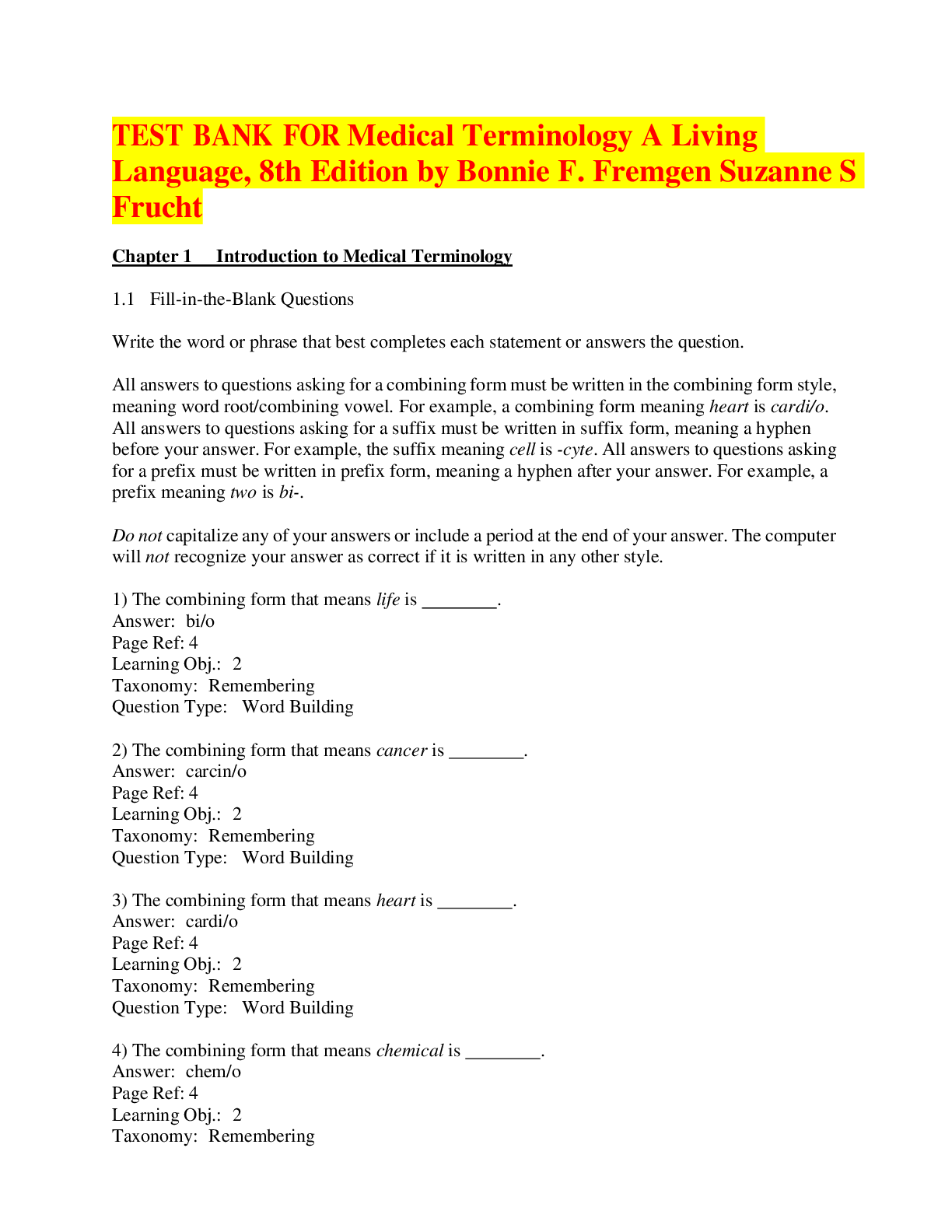
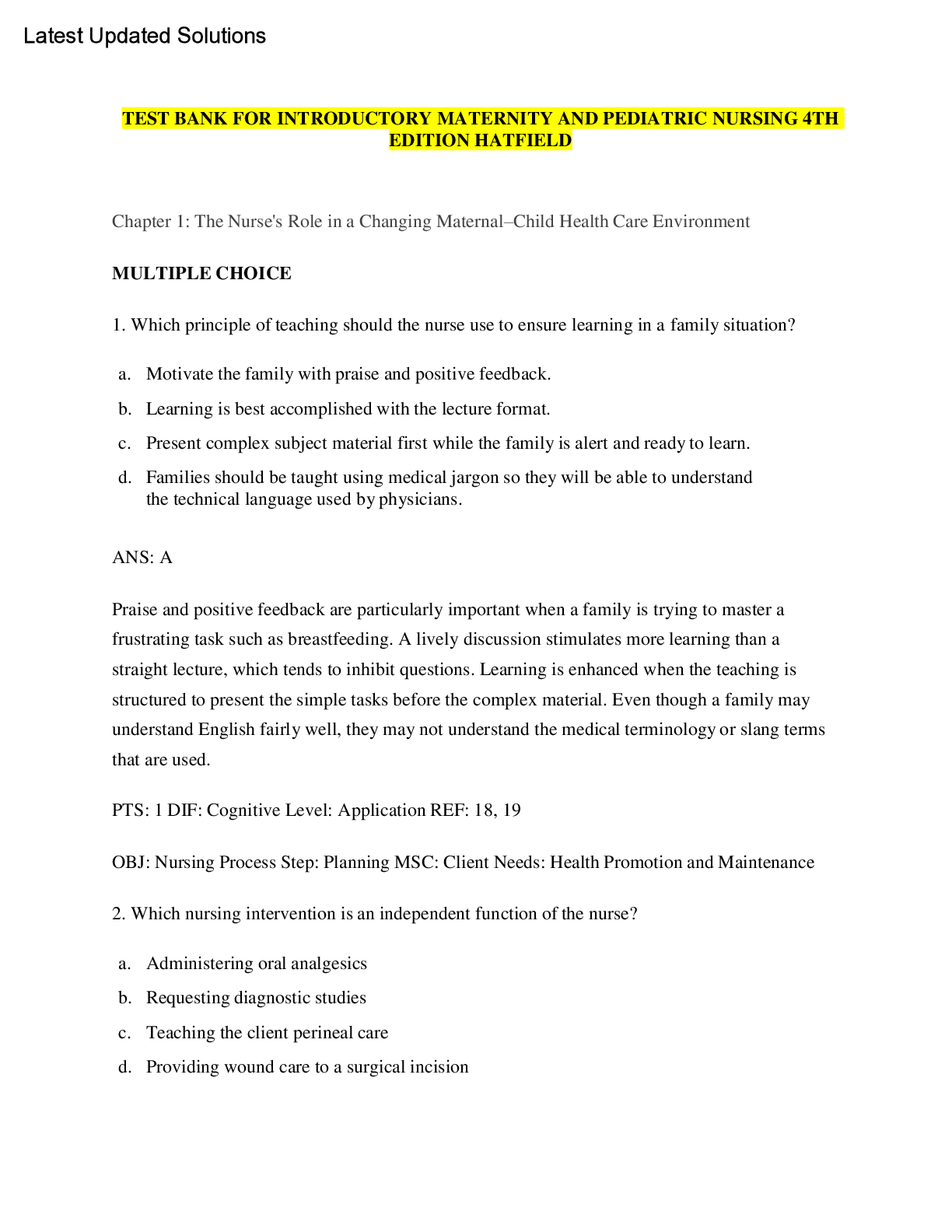



_compressed.png)
.png)
.png)

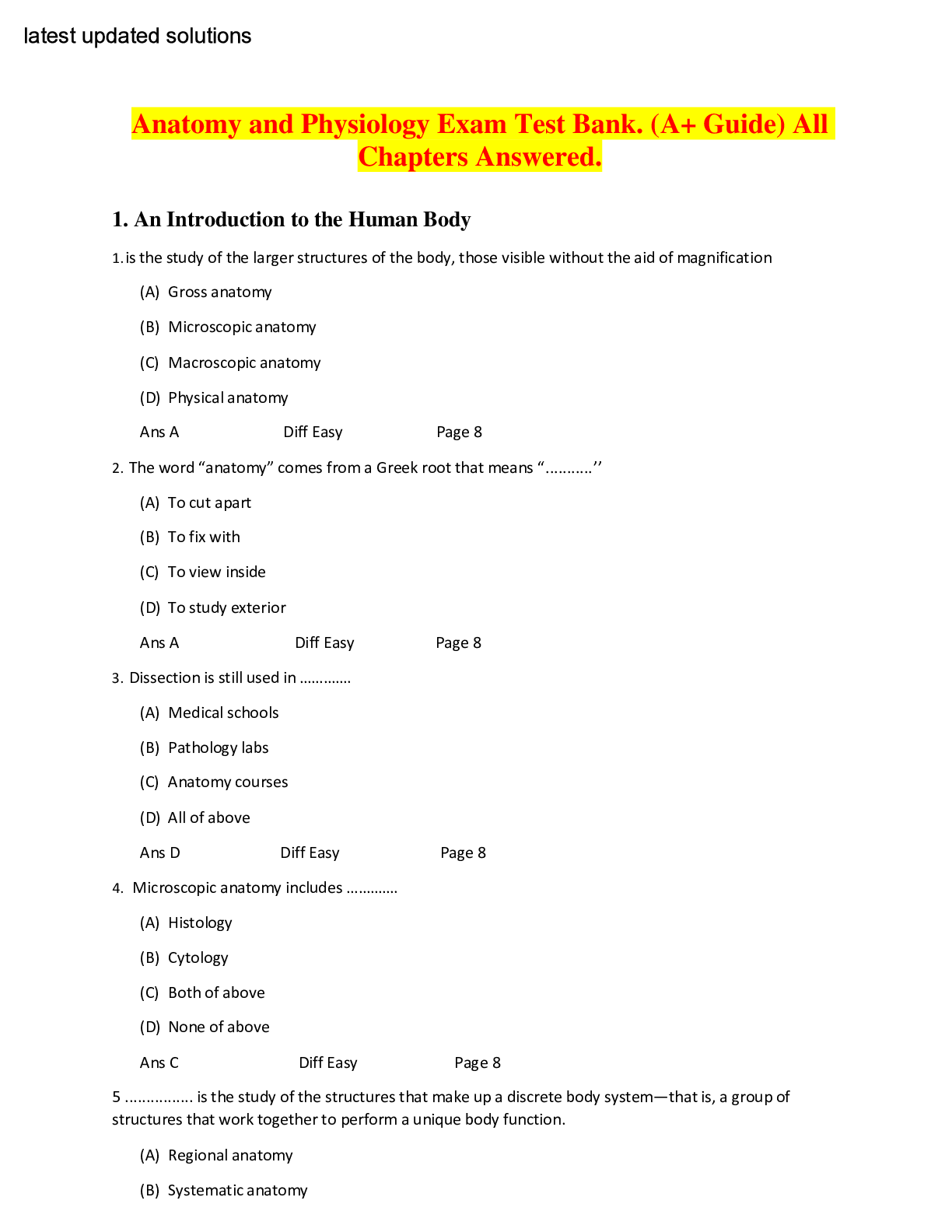
.png)
